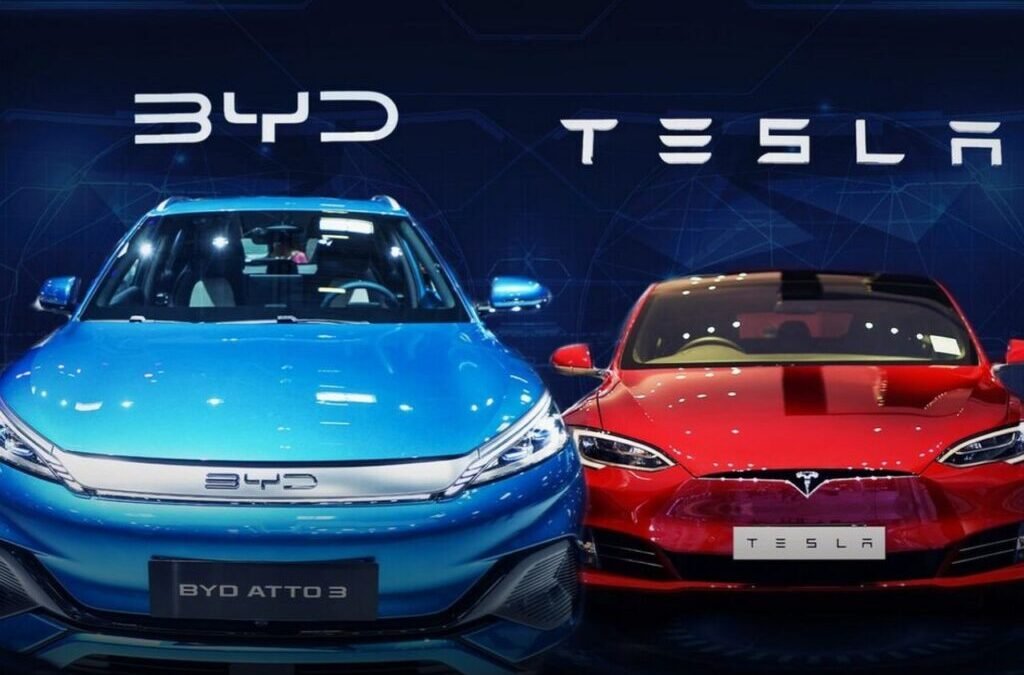Synopsis– Tesla has made its debut into the Indian Electric Vehicle market in July 2025, aiming at the luxury segment. it has launched its high-end, high-priced Model Y. While BYD has already established itself in the Indian EV ecosystem, it provides at prices that are comparably not as expensive as Tesla. Even though Tesla comes with innovation and global confirmed prestige; however, BYD’s lower-cost strategy is better suited for India’s price-sensitive and infrastructure-short country.
India is going through a transitional phase in the electric mobility segment, as Tesla officially launched its highly anticipated entry in July 2025. With the opening of its Experience Centre in Mumbai and bookings available for its premium Model Y, Tesla has made its intentions clear to participate in India’s rapidly growing EV market. It does, however, enter a market that is already being aggressively developed by the Chinese giant BYD, which has silently established a solid foundation with cheap models, semi-knockdown (SKD) assembly units, and policy-conducive business strategies.
With India targeting a 30% EV penetration by 2030, the war between Tesla and BYD may determine who rules the roads of the future in India. Whereas Tesla wows with technology and glamour, BYD rides on functionality and affordability. So, who is best placed to take on India’s quirky and varied EV market?
Tesla’s Entry Strategy into the Indian Markets
Going for the premium segment, Tesla has introduced the Model Y through the CBU (Completely Built-Up) route. With import costs driving prices up to Rs. 68 lakh, the car is aimed at India’s ultra-premium segment. Highlights:
- Model Y Launched: Price range starts at Rs. 59.58 lakh, and goes up to Rs. 68 lakh (ex-showroom).
- Sales Mode: Online and through Tesla Experience Centres.
- Charging Infrastructure: Being developed, and plans to partner with Indian players.
- Manufacturing Status: As of now, there will be no local production, but there are plans in the future regarding the same.
- Even with all the hype, Tesla’s present price is out of reach for the majority of Indian consumers. Moreover, without domestic manufacturing, Tesla has to deal with 100%+ import tariffs, so it is more of a status symbol than a volume seller.
BYD’s Ground-Up Approach
BYD has been locally producing EVs in India since 2022. It already has models such as the BYD e6 MPV and Atto 3 SUV, which are available at much lower prices. Highlight:
- e6 and Atto 3: Range of Rs. 29–34 lakh (ex-showroom).
- Local Assembly: Through SKD kits in Tamil Nadu.
- EV Market Share: Among top 5 EV producers in India mid-2025.
- Future Plans: Looking to go deeper into localization in spite of delays to its planned Rs. 1 billion JV with Megha Engineering.
- BYD’s approach is to provide solid, efficient, and value-for-money EVs while ensuring compliance with Indian regulations.
| Tesla vs BYD in India: Head-to-Head Comparison | ||
| Feature | Tesla | BYD |
| Product Range | Model Y (currently) | e6 MPV, Atto 3 SUV |
| Price Range | Rs. 60–68 lakh | Rs. 29–34 lakh |
| Market Segment | Luxury | Premium mid-range |
| Assembly/Manufacturing | CBU (imported) | SKD (semi-knockdown kits) |
| Government Policy Fit | Negotiating lower import duties | Aligned with Make in India |
| Charging Ecosystem | Building a proprietary network | Supports public networks |
| Sales Strategy | Direct-to-consumer | Dealership model + online |
Indian EV Market- Growth and Opportunity
India’s EV market will grow at a Compounded Annual Growth Rate (CAGR)of 49% between 2022 and 2030 to reach 17 million units per annum by the end of the decade. Two-wheelers rule the market, while passenger EVs are also gaining traction. Tesla’s price positioning at present restricts it from competing with the likes of Tata and BYD, which sell EVs in the range of Rs. 30 lakh.
| Market Share of Top EV Brands in India | |
| Brand | Market Share (%) |
| Tata Motors | 68% |
| MG Motor | 11% |
| BYD | 7% |
| Hyundai | 5% |
| Others (incl. Tesla) | 9% |
Government Policies and Their Impact
- In March 2025, India launched a new EV policy with the option of lowered import duties (15%) if the manufacturer:
- Commits to domestic manufacturing within 3 years.
- Dedicates at least Rs. 4,150 crore ($500 million) in investment.
- Secures 50% local value addition within 5 years.
- Tesla is in talks with the government to take advantage of this policy. With the codename of “Redwood”, Tesla is launching a lower-priced EV around Rs. 25 lakh. If this were to happen, Tesla would potentially directly rival BYD, Tata, and MG in the mass EV segment.
Future Challenges
- Tesla
- Exorbitant prices for CBU imports.
- Insufficient service network.
- Charging infrastructure not yet developed.
- Requires rapid local production to ramp up.
- BYD
- Security scanning of Chinese investment.
- Still woefully underdeveloped dealership and service network.
- Dominates global markets but faces stiff competition from Indian domestic brands like Tata.
Conclusion: Who Will Dominate Indian Roads?
BYD is very likely to continue its domination in the mid-range EV segment as of 2025, owing to local assembly (SKD), competitive pricing, and policy support. Tesla’s brand equity and progress towards localization could get it to flip the market share in the next 2–3 years. The ultimate winner will be the one that learns to adjust quickest to Indian tastes, that is, price consciousness, local servicing, and infrastructure preparedness. Until Tesla starts mass local production and supplies sub-Rs. 30 lakh models, BYD and indigenous brands will remain at the forefront on Indian roads.
Written by Adithya Menon
The post Tesla vs BYD: Which EV Gaint Will Rule the Indian Roads in Future? appeared first on Trade Brains.

